Selected Issues Associated with the Operational and Power Supply Reliability of Fire Alarm Systems
Abstract
:1. Introduction
- in the basic operating mode of all ESS, without detection of a burglary or intrusion and fire-technical state-monitoring;
- in the event of the aforementioned hazards occurring-alarm state.
2. Literature Review
3. Energy Balance Determination Process Graph for FAS Operated in Buildings, Critical Infrastructure, and over a Vast Transport Area
- A concentrated FAS, with the simplest functional structure, where detection circuits and loops with sensors detecting characteristic fire features always start and terminate in an FACU;
- Scattered FAS, of a complex functional structure. Depending on building volume [m3] or the size of a vast area [km2], such a system has from two to more than ten or several dozen FACUs. Organization, developing a fire scenario, and control matrix for all FAS elements is very complex and based on the use of dedicated computer applications. FACUs may be connected in a single loop, star, or bus with a double transmission line (optical fibre), since they have to meet specific reliability requirements [92,93,94]. A scattered system always has a master FACU, with others in slave mode. Detection loops must always start and terminate in a single fire alarm control unit;
- A mixed-structure FAS is a combination of two aforementioned functional structures, concentrated and scattered. Usually, concentrated FAS within such a solution implements fire protection for the most fire-endangered facilities-fuel storages, archives, museums, etc.
- (1)
- incorrect power consumption readings for individual devices in the monitoring and alarm states,
- (2)
- incorrect assumptions of the total device number (undershot or overshot),
- (3)
- failure to consider all devices connected to the FAS in the current balance,
- (4)
- overshooting detection loop or circuit current load,
- (5)
- (6)
- (1)
- replacing a detector with a new one, with greater consumption of power from a detection loop or circuit,
- (2)
- replacing signalling devices with ones exhibiting increased power consumption,
- (3)
- (4)
4. Operation Process Analysis for a Selected FAS Operated in CI Facilities
- R0(t) is the probability function of the system staying in the SPZ state of full fitness;
- QZBS(t), QZBD1(t), QZBD2(t), QZBDn−1(t), QZBD21(t), QZBD22(t), QZBD23(t), QZBD2n−1(t), QZSD(t), QB1(t) are the probability function for FAS staying in individual safety hazard states;
- QB(t) is the probability function of the system staying in the SB state of safety unreliability;
- λCSP is the intensity of transition from the SPZ state of full fitness to SB the state of safety unreliability;
- µCSP is the intensity of transition from the SB state of safety unreliability to the SPZ state of full fitness;
- λS1, λD, … are the intensity of transitions from the SPZ state of full fitness, the SZB state of the safety hazard, or the SZB state of safety unreliability-n accordance with designations in Figure 7;
- µS1, µD2, … is the intensity of transitions from the SZB state of the safety hazard to the SPZ state of full fitness, and the state of safety unreliability to the state of safety hazard–in accordance with designations in Figure 7.
5. Conclusions
Author Contributions
Funding
Institutional Review Board Statement
Informed Consent Statement
Data Availability Statement
Conflicts of Interest
Nomenclature
| FAS | Fire Alarm System, |
| FACU | Fire Alarm Control Unit, |
| ESS | Electronic Security Systems |
| CI | Critical Infrastructure |
| kg(t) | availability coefficient, |
| µ | recovery intensity coefficient, |
| λ | damage intensity coefficient, |
| RO(t) | probability function of an FAS staying in the SPZ state (full fitness) |
| QZB(t) | probability function of an FAS staying in the SZB state (safety hazard) |
| QB(t) | probability function of an FAS staying in the SPZ state (safety unreliability) |
| λZB1 | damage intensity, transition of a selected FAS from the SPZ state to the SZB state, |
| μPZ1 | recovery intensity, transition from the SZB state to the SPZ state, |
| MCP | Manual Call Point |
| AWS | Audio Warning System |
| SS | signalling circuit, |
| SD1 | detection loop No. 1, |
| λCSP | intensity of transition from the SPZ state of full fitness to the SB state of safety unreliability; |
| AFSTD | alarm and failure signal transmission device |
| FED | fixed (fire) extinguishing device |
| k | margin coefficient for energy balance calculations, |
| TF1–TF9 | test fire designations, |
| ABPS | automatic backup power switch, |
| SSWiN | Systemu Sygnalizacji Włamania i Napadu, |
| PIR | Passive Infra-Red, |
| ACS | Access Control Systems, |
| CCTV | Closed-circuit TV, |
| ABPS | Automatic Backup Power Switch wymuszenia zakłócające, |
| AWS | Audio Warning system |
| K | reserve coefficient, usually taken as 1.25 |
| I1 | determined FAS power consumption in the technical state of monitoring for the first fire system, |
| t1 | required operating time of the FAS in the technical state of alarm, |
| I2 | determined FAS power consumption in the technical state of alarm, |
| t2 | required FAS operating time in the technical state of alarm, |
| D2 | coefficient associated with reduced battery capacity resulting, from drawing large-value power under alarm conditions |
References
- Klimczak, T.; Paś, J. Basics of Exploitation of Fire Alarm Systems in Transport Facilities; Military University of Technology: Warsaw, Poland, 2020. [Google Scholar]
- Klimczak, T.; Paś, J. Selected issues of the reliability and operational assessment of a fire alarm system. Eksploat. Niezawodn. Maint. Reliab. 2019, 21, 553–561. [Google Scholar] [CrossRef]
- Frangopol, D.M.; Liu, M. Maintenance and management of civil infrastructure based on condition, safety, optimization, and lifecycle cost. Struct. Infrastruct. Eng. 2007, 3, 29–41. [Google Scholar] [CrossRef]
- Kołowrocki, K.; Soszyńska-Budny, J. Critical Infrastructure Safety Indicators. In Proceedings of the IEEE International Conference on Industrial Engineering and Engineering Management (IEEM), Bangkok, Thailand, 16–19 December 2018; pp. 1761–1764. [Google Scholar] [CrossRef]
- Government Security Center. National Critical Infrastructure Protection Programme in Poland. Rev. 08.2020. Available online: https://www.gov.pl/attachment/ee334990-ec9c-42ab-ae12-477608d94eb1 (accessed on 18 August 2021).
- Jafari, M.J.; Pouyakian, M.; Khanteymoori, A.; Hanifi, S.M. Reliability evaluation of fire alarm systems using dynamic Bayesian networks and fuzzy fault tree analysis. J. Loss Prev. Process Ind. 2020, 67, 104229. [Google Scholar] [CrossRef]
- Rosiński, A. Modelling the Maintenance Process of Transport Telematics Systems; Publishing House Warsaw University of Technology: Warsaw, Poland, 2015. [Google Scholar]
- Regulation of Ministry of the Interior and Administration of Poland (MSWiA) of 7 June 2010 (Journal of Laws of the Republic of Poland No. 109, Item 719) Concerning Fire Protection of Buildings and Other Facilities and Grounds; Ministry of the Interior and Administration of Poland: Warsaw, Poland, 2021. Available online: https://sip.lex.pl/akty-prawne/dzu-dziennik-ustaw/ochronaprzeciwpożarowa-budynkow-innych-obiektow-budowlanych-i-terenow-17626053 (accessed on 17 November 2021).
- Andrzejczak, K.; Bukowski, L. A method for estimating the probability distribution of the lifetime for new technical equipment based on expert judgement. Eksploat. Niezawodn. Maint. Reliab. 2021, 23, 757–769. [Google Scholar] [CrossRef]
- Migdalski, J. Reliability Engineering—A Handbook; ATR: Bydgoszcz, Poland, 1992. [Google Scholar]
- Pas, J.; Rosinski, A.; Chrzan, M.; Bialek, K. Reliability-operational analysis of the LED lighting module including electromagnetic interference. IEEE Trans. Electromagn. Compat. 2020, 62, 2747–2758. [Google Scholar] [CrossRef]
- Paś, J.; Rosiński, A.; Białek, K. A reliability-operational analysis of a track-side CCTV cabinet taking into account interference. Bull. Pol. Acad. Sci. Tech. Sci. 2021, 69, e136747. [Google Scholar] [CrossRef]
- Gupta, S.; Kanwar, S.; Kashyap, M. Performance characteristics and assessment of fire alarm system. Mater. Today Proc. 2022, 57, 2036–2040. [Google Scholar] [CrossRef]
- Pati, V.B.; Joshi, S.P.; Sowmianarayana, R.; Vedavathi, M.; Rana, R.K. Simulation of Intelligent Fire Detection and Alarm System for a Warship. Def. Sci. J. 1989, 39, 79–94. [Google Scholar] [CrossRef] [Green Version]
- Keding, L. An optimization of intelligent fire alarm system for high-rise building based on ANASYS. In Intelligence Computation and Evolutionary Computation; Du, Z., Ed.; Springer: Berlin/Heidelberg, Germany, 2013; pp. 415–421. [Google Scholar] [CrossRef]
- Østrem, L.; Sommer, M. Inherent fire safety engineering in complex road tunnels—Learning between industries in safety management. Saf. Sci. 2021, 134, 105062. [Google Scholar] [CrossRef]
- Hulida, E.; Pasnak, I.; Koval, O.; Tryhuba, A. Determination of the Critical Time of Fire in the Building and Ensure Successful Evacuation of People. Period. Polytech. Civ. Eng. 2019, 63, 308–316. [Google Scholar] [CrossRef]
- Dziula, P.; Paś, J. Low Frequency Electromagnetic Interferences Impact on Transport Security Systems Used in Wide Transport Areas. TransNav Int. J. Mar. Navig. Saf. Sea Transp. 2018, 12, 251–258. [Google Scholar] [CrossRef] [Green Version]
- Siergiejczyk, M.; Paś, J.; Dudek, E. Reliability analysis of aerodrome’s electronic security systems taking into account electromagnetic interferences. In Safety and Reliability—Theory and Applications, Proceedings of the 27th European Safety and Reliability Conference (Esrel 2017), Portorož, Slovenia, 18–22 June 2017; Cepin, M., Briš, R., Eds.; CRC Press/Balkema: Schipholewh, The Netherlands, 2017; pp. 2285–2292. [Google Scholar]
- Burdzik, R.; Konieczny, Ł.; Figlus, T. Concept of on-board comfort vibration monitoring system for vehicles. In Proceedings of the Communications in Computer and Information Science, Activities of Transport Telematics 13th International Conference on Transport Systems Telematics, TST 2013, Katowice-Ustron, Poland, 23–26 October 2013; Mikulski, J., Ed.; Springer: Berlin/Heidelberg, Germany, 2013; Volume 395, pp. 418–425. [Google Scholar]
- Żółtowski, B.; Niziński, S. Modeling of Machine Exploitation Processes; Markar: Bydgoszcz, Poland, 2002. [Google Scholar]
- Duer, S. Examination of the reliability of a technical object after its regeneration in a maintenance system with an artificial neural network. Neural Comput. Appl. 2012, 21, 523–534. [Google Scholar] [CrossRef]
- Suproniuk, M.; Paś, J. Analysis of electrical energy consumption in a public utility buildings. Przegl Elektrotechniczny 2019, 95, 97–100. [Google Scholar] [CrossRef]
- Krzykowski, M.; Paś, J.; Rosiński, A. Assessment of the level of reliability of power supplies of the objects of critical infrastructure. IOP Conf. Ser. Earth Environ. Sci. 2019, 214, 012018. [Google Scholar] [CrossRef]
- Vasile, D.-C.; Svasta, P.; Pantazica, M. Preventing the Temperature Side Channel Attacks on Security Circuits. In Proceedings of the 2019 IEEE 25th International Symposium for Design and Technology in Electronic Packaging (SIITME), Cluj-Napoca, Romania, 23–26 October 2019; IEEE: Piscataway Township, NJ, USA, 2019; pp. 244–247. [Google Scholar]
- Chung, I.-H.; Lin, Y.-H. Exploring the Impact of Parallel Architecture on Improving Adaptable Neuro-Fuzzy Inference Systems for Gas-Insulated Switch Defect Recognition. Energies 2022, 15, 3940. [Google Scholar] [CrossRef]
- Zhao, H.; Schwabe, A.; Schläfli, F.; Thrash, T.; Aguilar, L.; Dubey, R.K.; Karjalainen, J.; Hölscher, C.; Helbing, D.; Schinazi, V.R. Fire evacuation supported by centralized and decentralized visual guidance systems. Saf. Sci. 2022, 145, 105451. [Google Scholar] [CrossRef]
- Shaw, E.; Roper, T.; Nilsson, T.; Lawson, G.; Cobb, S.V.; Miller, D. The heat is on: Exploring user behaviour in a multisensory virtual environment for fire evacuation. In Proceedings of the 2019 CHI Conference on Human Factors in Computing Systems, Glasgow, Scotland, 4–9 May 2019; pp. 1–13. [Google Scholar]
- Fridolf, K.; Nilsson, D.; Frantzich, H. Fire Evacuation in Underground Transportation Systems: A Review of Accidents and Empirical Research. Fire Technol. 2013, 49, 451–475. [Google Scholar] [CrossRef]
- Foggia, P.; Saggese, A.; Vento, M. Real-time fire detection for video-surveillance applications using a combination of experts based on color shape and motion. IEEE Trans. Circuits Syst. Video Technol. 2015, 25, 1545–1556. [Google Scholar] [CrossRef]
- Rahman, M.A.; Hasan, S.T.; Kader, M.A. Computer Vision Based Industrial and Forest Fire Detection Using Support Vector Machine (SVM). In Proceedings of the 2022 International Conference on Innovations in Science, Engineering and Technology (ICISET), Chittagong, Bangladesh, 26–27 February 2022; pp. 233–238. [Google Scholar] [CrossRef]
- Ding, L.; Khan, F.; Ji, J. Risk-based safety measure allocation to prevent and mitigate storage fire hazards. Process Saf. Environ. Prot. 2020, 135, 282–293. [Google Scholar] [CrossRef]
- Derbel, F. Performance improvement of fire detectors by means of gas sensors and neural networks. Fire Saf. J. 2004, 39, 383–398. [Google Scholar] [CrossRef]
- Liu, F.; Liu, Y.; Xiong, K.; Weng, M.; Wang, J. Experimental and numerical study on the smoke movement and smoke control strategy in a hub station fire. Tunn. Undergr. Space Technol. 2020, 96, 103177. [Google Scholar] [CrossRef]
- Chung, I.-H. Exploring the Influence of the Parameters’ Relationship between Reliability and Maintainability for Offshore Wind Farm Engineering. Energies 2022, 15, 5610. [Google Scholar] [CrossRef]
- Polak, R.; Laskowski, D.; Matyszkiel, R.; Łubkowski, P.; Konieczny, Ł.; Burdzik, R. Optimizing the data flow in a network communication between railway nodes. In Research Methods and Solutions to Current Transport Problems, Proceedings of the International Scientific Conference Transport of the 21st Century, Advances in Intelligent Systems and Computing, Ryn, Poland, 9–12 June 2019; Siergiejczyk, M., Krzykowska, K., Eds.; Springer: Cham, Switzerland, 2020; Volume 1032, pp. 351–362. [Google Scholar] [CrossRef]
- Caban, D.; Walkowiak, T. Dependability analysis of hierarchically composed system-of-systems. In Thirteenth International Conference on Dependability and Complex Systems DepCoS-RELCOMEX; Springer: Cham, Switzerland, 2019; pp. 113–120. [Google Scholar] [CrossRef]
- Kołowrocki, K.; Soszyńska-Budny, J. Reliability and Safety of Complex Technical Systems and Processes: Modeling—Identification—Prediction—Optimization; Springer: London, UK, 2011. [Google Scholar] [CrossRef]
- Grabski, F. Semi-Markov Processes: Applications in System Reliability and Maintenance; Elsevier: Amsterdam, The Netherlands, 2015. [Google Scholar]
- Bogalecka, M.; Kołowrocki, K. Minimization of critical infrastructure accident losses of chemical releases impacted by climateweather change. In Proceedings of the International Conference on Industrial Engineering and Engineering Management-IEEM, Bangkok, Thailand, 16–19 December 2018. [Google Scholar] [CrossRef]
- Lheurette, E. (Ed.) Metamaterials and Wave Control; ISTE and Wiley: London, UK, 2013. [Google Scholar]
- Stawowy, M.; Perlicki, K.; Sumiła, M. Comparison of uncertainty multilevel models to ensure ITS services. In Safety and Reliability: Theory and Applications, Proceedings of the European Safety and Reliability Conference ESREL 2017, Portoroz, Slovenia, 18–22 June 2017; Cepin, M., Bris, R., Eds.; CRC Press/Balkema: London, UK, 2017; pp. 2647–2652. [Google Scholar] [CrossRef]
- Bednarek, M.; Dąbrowski, T.; Olchowik, W. Selected practical aspects of communication diagnosis in the industrial network. J. KONBiN 2019, 49, 383–404. [Google Scholar] [CrossRef] [Green Version]
- Oszczypała, M.; Ziółkowski, J.; Małachowski, J. Reliability Analysis of Military Vehicles Based on Censored Failures Data. Appl. Sci. 2022, 12, 2622. [Google Scholar] [CrossRef]
- Geng, X.; Wen, Y.; Zhang, J.; Zhang, D. A Method to Supervise the Effect on Railway Radio Transmission of Pulsed Disturbances Based on Joint Statistical Characteristics. Appl. Sci. 2020, 10, 4814. [Google Scholar] [CrossRef]
- Valouch, J. Integrated alarm systems. In Computer Applications for Software Engineering, Disaster Recovery, and Business Continuity; Series: Communications in Computer and Information Science XVIII; Springer: Berlin/Heidelberg, Germany, 2012; Volume 340, pp. 369–379. ISSN 1865-0929. [Google Scholar]
- Jacyna, M.; Szczepański, E.; Izdebski, M.; Jasiński, S.; Maciejewski, M. Characteristics of event recorders in Automatic Train Control systems. Arch. Transp. 2018, 46, 61–70. [Google Scholar] [CrossRef]
- Kornaszewski, M. Modelling of exploitation process of the railway traffic control device. WUT J. Transp. Eng. 2019, 124, 53–63. [Google Scholar] [CrossRef]
- Suproniuk, M.; Skibko, Z.; Stachno, A. Diagnostics of some parameters of electricity generated in wind farms. Przegląd Elektrotechniczny 2019, 95, 105–108. [Google Scholar] [CrossRef]
- Duer, S. Assessment of the Operation Process of Wind Power Plant’s Equipment with the Use of an Artificial Neural Network. Energies 2020, 13, 2437. [Google Scholar] [CrossRef]
- Scheffey, J.; Darwin, R.; Leonard, J. Evaluating Firefighting Foams for Aviation Fire Protection. Fire Technol. 1995, 31, 224–243. [Google Scholar] [CrossRef]
- Serio, M.A.; Bonamno, A.S.; Knight, K.S.; Newman, J.S. Fourier Transform Infrared Diagnostics for Improved Fire Detection Systems; NIST Annual Conference on Fire Research: Gaithersburg, MD, USA, 1996. [Google Scholar]
- Epstein, B.; Weissman, I. Mathematical Models for Systems Reliability; CRC Press/Taylor & Francis Group: Boca Raton, FL, USA, 2008. [Google Scholar]
- Cha, J.H.; Finkelstein, M. Point Processes for Reliability Analysis Shocks and Repairable Systems; Springer: Berlin/Heidelberg, Germany, 2018. [Google Scholar]
- Danish, M.; Luo, S. A New Route to Enhance the Packing Density of Buckypaper for Superior Piezoresistive Sensor Characteristics. Sensors 2020, 20, 2904. [Google Scholar] [CrossRef] [PubMed]
- Duer, S.; Zajkowski, K.; Harničárová, M.; Charun, H.; Bernatowicz, D. Examination of Multivalent Diagnoses Developed by a Diagnostic Program with an Artificial Neural Network for Devices in the Electric Hybrid Power Supply System “House on Water”. Energies 2021, 14, 2153. [Google Scholar] [CrossRef]
- Duer, S.; Duer, R.; Mazuru, S. Determination of the expert knowledge base on the basis of a functional and diagnostic analysis of a technical object. Nonconv. Technol. Rev. 2016, 20, 23–29. Available online: http://revtn.ro/index.php/revtn/article/view/115/76 (accessed on 12 August 2021).
- Xu, S.; Li, X. Analysis on thermal reliability of key electronic components on PCB board. In Proceedings of the 2011 Interna-tional Conference on Quality, Reliability, Risk, Maintenance, and Safety Engineering, Xi’an, China, 17–19 June 2011; Huang, H.Z., Zuo, M.J., Jia, X., Liu, Y., Eds.; IEEE: Xi’an, China, 2011; pp. 52–54. [Google Scholar]
- Jakubowski, K.; Paś, J.; Rosiński, A. The Issue of Operating Security Systems in Terms of the Impact of Electromagnetic Interference Generated Unintentionally. Energies 2021, 14, 8591. [Google Scholar] [CrossRef]
- Tooley, M.H.; Wyatt, D. Aircraft Electrical and Electronic Systems: Principles, Operation and Maintenance; Routledge: London, UK; New York, NY, USA, 2011; ISBN 978-0-7506-8695-2. [Google Scholar]
- Młynarski, S.; Pilch, R.; Smolnik, M.; Szybka, J.; Wiązania, G. A model of an adaptive strategy of preventive maintenance of complex technical objects. Eksploat. Niezawodn. Maint. Reliab. 2020, 22, 35–41. [Google Scholar] [CrossRef]
- Dziula, P.; Kołowrocki, K.; Soszyńska-Budny, J. Maritime Transportation System Safety-Modeling and Identification. TransNav Int. J. Mar. Navig. Saf. Transp. 2013, 7, 169–175. [Google Scholar] [CrossRef]
- Soszyńska-Budny, J. General approach to critical infrastructure safety modelling. In Safety Analysis of Critical Infrastructure. Lecture Notes in Intelligent Transportation and Infrastructure; Springer: Cham, Switzerland, 2021. [Google Scholar] [CrossRef]
- Paś, J.; Klimczak, T.; Rosiński, A.; Stawowy, M. The Analysis of the Operational Process of a Complex Fire Alarm System Used in Transport Facilities. Build. Simul. 2022, 15, 615–629. [Google Scholar] [CrossRef]
- Liu, Z.; Kim, A.K. Review of Recent Developments in Fire Detection Technologies. J. Fire Prot. Eng. 2003, 13, 129–151. [Google Scholar] [CrossRef] [Green Version]
- Stawowy, M.; Olchowik, W.; Rosiński, A.; Dąbrowski, T. The Analysis and Modelling of the Quality of Information Ac-quired from Weather Station Sensors. Remote Sens. 2021, 13, 693. [Google Scholar] [CrossRef]
- Wang, Y.; Zhang, Q.; Soutis, C.; Gresil, M. Development of a Fire Detection and Suppression System for a Smart Air Cargo Container. Aeronaut. J. 2021, 125, 205–222. [Google Scholar]
- Oszczypała, M.; Ziółkowski, J.; Małachowski, J. Analysis of Light Utility Vehicle Readiness in Military Transportation Systems Using Markov and Semi-Markov Processes. Energies 2022, 15, 5062. [Google Scholar] [CrossRef]
- Lewczuk, K.; Kłodawski, M.; Gepner, P. Energy Consumption in a Distributional Warehouse: A Practical Case Study for Different Warehouse Technologies. Energies 2021, 14, 2709. [Google Scholar] [CrossRef]
- Jakubowski, K.; Paś, J.; Duer, S.; Bugaj, J. Operational Analysis of Fire Alarm Systems with a Focused, Dispersed and Mixed Structure in Critical Infrastructure Buildings. Energies 2021, 14, 7893. [Google Scholar] [CrossRef]
- Łukasiak, J.; Rosiński, A.; Wiśnios, M. The Impact of Temperature of the Tripping Thresholds of Intrusion Detection System Detection Circuits. Energies 2021, 14, 6851. [Google Scholar] [CrossRef]
- Avazov, K.; Mukhiddinov, M.; Makhmudov, F.; Cho, Y.I. Fire Detection Method in Smart City Environments Using a Deep-Learning-Based Approach. Electronics 2022, 11, 73. [Google Scholar] [CrossRef]
- Kozłowski, E.; Borucka, A.; Swiderski, A. Application of the logistic regression for determining transition probability matrix of operating states in the transport systems. Eksploat. Niezawodn. Maint. Reliab. 2020, 22, 192–200. [Google Scholar] [CrossRef]
- Młynarski, S.; Pilch, R.; Smolnik, M.; Szybka, J. Methodology of network systems reliability assessment on the example of urban transport. Eksploat. Niezawodn.-Maint. Reliab. 2018, 20, 278–283. [Google Scholar] [CrossRef]
- Stawowy, M.; Rosiński, A.; Siergiejczyk, M.; Perlicki, K. Quality and Reliability-Exploitation Modeling of Power Supply Systems. Energies 2021, 14, 2727. [Google Scholar] [CrossRef]
- Karami, H.; Azadifar, M.; Wang, Z.; Rubinstein, M.; Rachidi, F. Single-Sensor EMI Source Localization Using Time Reversal: An Experimental Validation. Electronics 2021, 10, 2448. [Google Scholar] [CrossRef]
- Jose, V.T.; Vicente, D.-C.; Xi, Y. Reliability and Maintenance Management Analysis on Offshore Wind Turbines (OWTs). Energies 2021, 14, 7662. [Google Scholar]
- Kaniewski, P. Extended Kalman Filter with Reduced Computational Demands for Systems with Non-Linear Measurement Models. Sensors 2020, 20, 1584. [Google Scholar] [CrossRef] [PubMed] [Green Version]
- Kaniewski, P.; Komorniczak, W.; Lesnik, C.; Cyrek, J.; Susek, W.; Serafin, P.; Labowski, M. S-Band and Ku-Band SAR System Development for UAV-Based Applications. Metrol. Meas. Syst. 2019, 26, 53–64. [Google Scholar]
- Chrzan, M. Effect of uniform time on the transmission of signals in rail open systems. Arch. Transp. 2022, 61, 39–49. [Google Scholar] [CrossRef]
- Ren, M.; Dong, M.; Ren, Z.; Peng, H.-D.; Qiu, A.-C. Transient earth voltage measurement in PD detection of artificial defect models in SF6. IEEE Trans. Plasma Sci. 2012, 40, 2002–2008. [Google Scholar] [CrossRef]
- Li, F.; Chen, S.; Wang, X.; Feng, F. Pedestrian evacuation modeling and simulation on metro platforms considering panic impacts. Procedia-Soc. Behav. Sci. 2014, 138, 314–322. [Google Scholar] [CrossRef]
- Filizzola, C.; Corrado, R.; Marchese, F.; Mazzeo, G.; Paciello, R.; Pergola, N.; Tramutoli, V. Rst-fires an exportable algorithm for early fire detection and monitoring: Description implementation and field validation in the case of the msg-seviri sensor. Remote Sens. Environ. 2016, 186, 196–216. [Google Scholar] [CrossRef]
- Wu, H.; Wu, D.; Zhao, J. An intelligent fire detection approach through cameras based on computer vision methods. Process Saf. Environ. Prot. 2019, 127, 245–256. [Google Scholar] [CrossRef]
- Kim, Y.-H.; Kim, A.; Jeong, H.-Y. RGB color model based the fire detection algorithm in video sequences on wireless sensor network. Int. J. Distrib. Sensor Netw. 2014, 10, 923609. [Google Scholar] [CrossRef]
- Namozov, A.; Cho, Y.I. An efficient deep learning algorithm for fire and smoke detection with limited data. Adv. Electr. Comput. Eng. 2018, 18, 121–128. [Google Scholar] [CrossRef]
- Kubica, P.; Boroń, S.; Czarnecki, L.; Węgrzyński, W. Maximizing the retention time of inert gases used in fixed gaseous extinguishing systems. Fire Saf. J. 2016, 80, 1–8. [Google Scholar] [CrossRef]
- Idris, A.M.; Rusli, R.; Burok, N.A.; Mohd Nabil, N.H.; Ab Hadi, N.S.; Abdul Karim, A.H.M.; Ramli, A.F.; Mydin, I. Human factors influencing the reliability of fire and gas detection system. Process Saf. Prog. 2020, 39, e12116. [Google Scholar] [CrossRef] [Green Version]
- Zieja, M.; Szelmanowski, A.; Pazur, A.; Kowalczyk, G. Computer Life-Cycle Management System for Avionics Software as a Tool for Supporting the Sustainable Development of Air Transport. Sustainability 2021, 13, 1547. [Google Scholar] [CrossRef]
- Szelmanowski, A.; Zieja, M.; Głyda, K. Dynamic Properties Modeling of the Thermoelectric Fire Sensors in the Aircraft Fire Suppression System. J. KONBiN 2017, 44, 293–307. [Google Scholar] [CrossRef] [Green Version]
- Siergiejczyk, M.; Paś, J.; Rosiński, A. Evaluation of safety of highway CCTV system’s maintenance. In Communications in Computer and Information Science; Springer: Berlin/Heidelberg, Germany, 2014; Volume 471, pp. 69–79. [Google Scholar]
- Duer, S.; Rokosz, K.; Zajkowski, K.; Bernatowicz, D.; Ostrowski, A.; Woźniak, M.; Iqbal, A. Intelligent Systems Supporting the Use of Energy Devices and Other Complex Technical Objects: Modeling, Testing, and Analysis of Their Reliability in the Operating Process. Energies 2022, 15, 6414. [Google Scholar] [CrossRef]
- Siergiejczyk, M.; Paś, J.; Rosiński, A. Modeling of process of exploitation of transport telematics systems with regard to electromagnetic interferences. In Communications in Computer and Information Science; Springer International Publishing: Cham, Switzerland, 2015; Volume 531, pp. 99–107. [Google Scholar] [CrossRef]
- Paś, J. Operation of Electronic Transportation Systems; Publishing House University of Technology and Humanities: Radom, Poland, 2015. [Google Scholar]
- Chumuang, N.; Ketcham, M.; Yingthawornsuk, T. CCTV based surveillance system for railway station security. In Proceedings of the International Conference on Digital Arts. Media and Technology (ICDAMT), Phayao, Thailand, 25–28 February 2018; pp. 7–12. [Google Scholar]
- Dyduch, J.; Paś, J.; Rosiński, A. The Basic of the Exploitation of Transport Electronic Systems; Publishing House of Radom University of Technology: Radom, Poland, 2011. [Google Scholar]
- Duer, S.; Scaticailov, S.; Paś, J.; Duer, R.; Bernatowicz, D. Taking decisions in the diagnostic intelligent systems on the basis information from an artificial neural network. In Proceedings of the 22nd International Conference on Innovative Manufacturing Engineering and Energy—IManE&E 2018, MATEC Web of Conferences 178, Chişinău, Moldova, 31 May–2 June 2018; Volume 178, pp. 1–6. [Google Scholar] [CrossRef]
- Stawowy, M.; Duer, S.; Paś, J.; Wawrzyński, W. Determining information quality in ICT systems. Energies 2021, 14, 5549. [Google Scholar] [CrossRef]
- Sholanke, A.; Oche, A.; Paul, O.; Taylor, G. Fire Emergency Safety Preparedness in the College of Leadership Development Studies Building in Covenant. Civ. Eng. Archit. 2020, 8, 1463–1480. [Google Scholar]
- Stawowy, M. Method of Multilayer Modeling of Uncertainty in Estimating the Information Quality of ICT Systems in Transport; Publishing House Warsaw University of Technology: Warsaw, Poland, 2019. [Google Scholar]
- Paś, J.; Rosiński, A.; Białek, K. A reliability-exploitation analysis of a static converter taking into account electromagnetic interference. Transp. Telecommun. 2021, 22, 217–229. [Google Scholar] [CrossRef]
- Chrzan, M.; Kornaszewski, M.; Ciszewski, T. Renovation of marine telematics objects in the process of exploitation. In Management Perspective for Transport Telematics; Springer: Cham, Switzerland, 2018; pp. 337–351. [Google Scholar] [CrossRef]
- Zajkowski, K. Two-stage reactive compensation in a three-phase four-wire systems at nonsinusoidal periodic waveforms. Electr. Power Syst. Res. 2020, 184, 106296. [Google Scholar] [CrossRef]
- Żyluk, A.; Kuźma, K.; Grzesik, N.; Zieja, M.; Tomaszewska, J. Fuzzy Logic in Aircraft Onboard Systems Reliability Evaluation—A New Approach. Sensors 2021, 21, 7913. [Google Scholar] [CrossRef]
- Zajkowski, K.; Rusica, I.; Palkova, Z. The use of CPC theory for energy description of two nonlinear receivers. MATEC Web Conf. 2018, 178, 09008. [Google Scholar] [CrossRef]
- Stefaniuk, D.; Sobótka, M.; Jarczewska, K.; Logoń, D.; Majcher, K.; Musiał, M.; Niewiadomski, P.; Pakos, W.; Różański, A.; Trapko, T. Microstructure properties of cementitious mortars with selected additives for electromagnetic waves absorbing applications. Cem. Concr. Compos. 2022, 134, 104732. [Google Scholar] [CrossRef]
- Duer, S. Diagnostic system with an artificial neural network in diagnostics of an analogue technical object. Neural Comput. Appl. 2010, 19, 55–60. [Google Scholar] [CrossRef]
- Świderski, A.; Jóźwiak, A.; Jachimowski, R. Operational quality measures of vehicles applied for the transport services evaluation using artificial neural networks. Eksploat. Niezawodn.-Maint. Reliab. 2018, 20, 292–299. [Google Scholar] [CrossRef]
- Duer, S. Diagnostic system for the diagnosis of a reparable technical object, with the use of an artificial neural network of RBF type. Neural Comput. Appl. 2010, 19, 691–700. [Google Scholar] [CrossRef]
- Białoń, A.; Białek, K.; Wetoszka, P. Analysis of emission tests of electromagnetic disturbancesin diesel-electric locomotives. 2nd International Scientific and Practical Conference “Energy-Optimal Technologies, Logistic and Safety on Transport” (EOT-2019). MATEC Web Conf. 2019, 294, 02001. [Google Scholar] [CrossRef]
- Żyluk, A.; Zieja, M.; Szelmanowski, A.; Tomaszewska, J.; Perlińska, M.; Głyda, K. Electrical Disturbances in Terms of Methods to Reduce False Activation of Aerial Fire Protection Systems. Sensors 2022, 22, 8059. [Google Scholar] [CrossRef]
- Wang, Z.; Li, H.; Chu, Z.; Zhang, C.; Yang, Z.; Shao, T.; Hu, Y. A Review of EMI Research in Modular Multilevel Converter for HVDC Applications. IEEE Trans. Power Electron. 2022, 37, 14482–14498. [Google Scholar] [CrossRef]
- Ying, X.; Zhang, X.P.; Yang, C. Commutation failure elimination of LCC HVDC systems using thyristor-based controllable capacitors. IEEE Trans. Power Deliv. 2017, 33, 1448–1458. [Google Scholar]
- Watral, Z.; Michalski, A. Selected Problems of Power Sources for Wireless Sensors Networks. IEEE Instrum. Meas. Mag. 2013, 16, 37–43. [Google Scholar] [CrossRef]
- Smolenski, R.; Lezynski, P.; Bojarski, J.; Drozdz, W.; Long, L.C. Electromagnetic compatibility assessment in multiconverter power systems—Conducted interference issues. Measurement 2020, 165, 108119. [Google Scholar] [CrossRef]

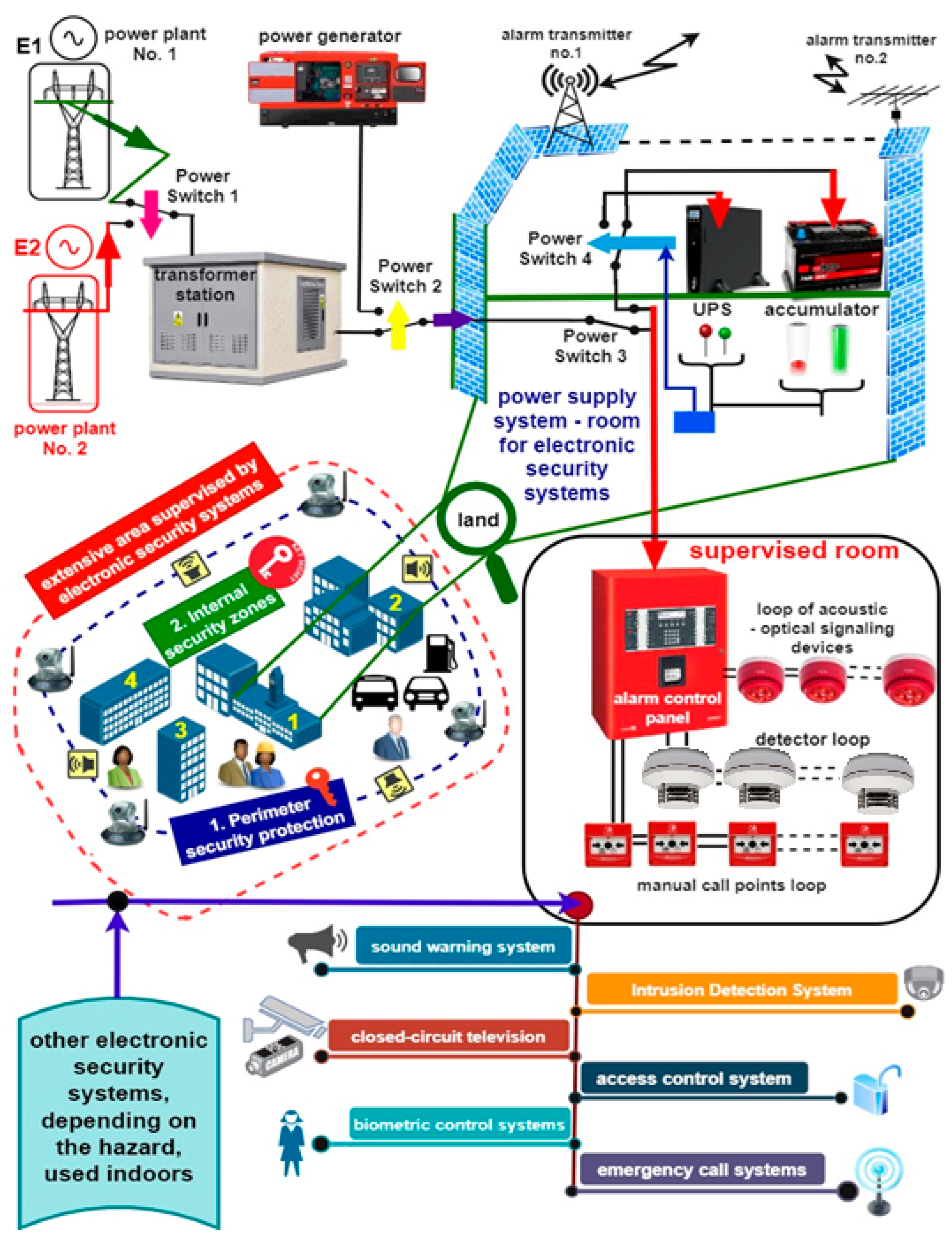

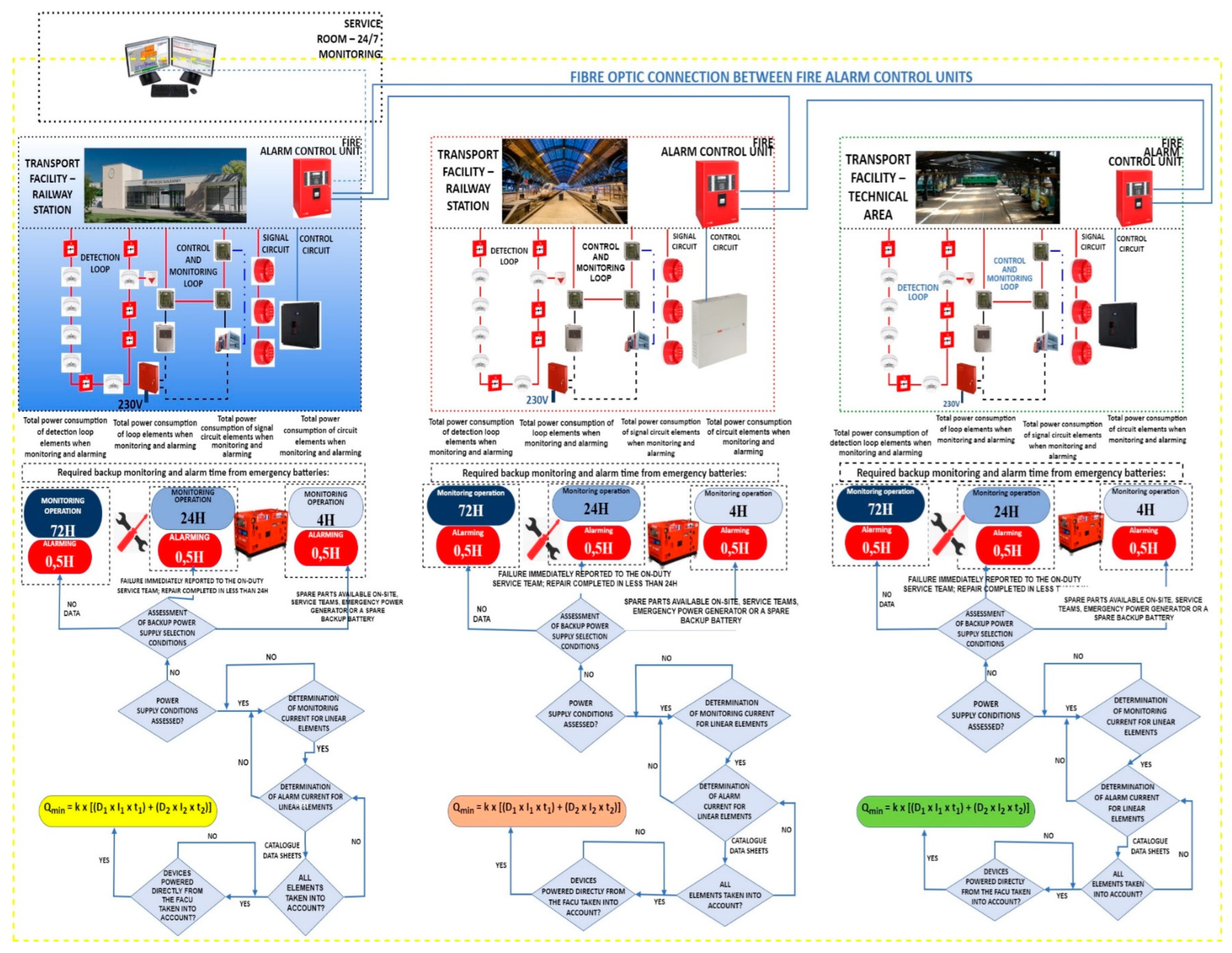
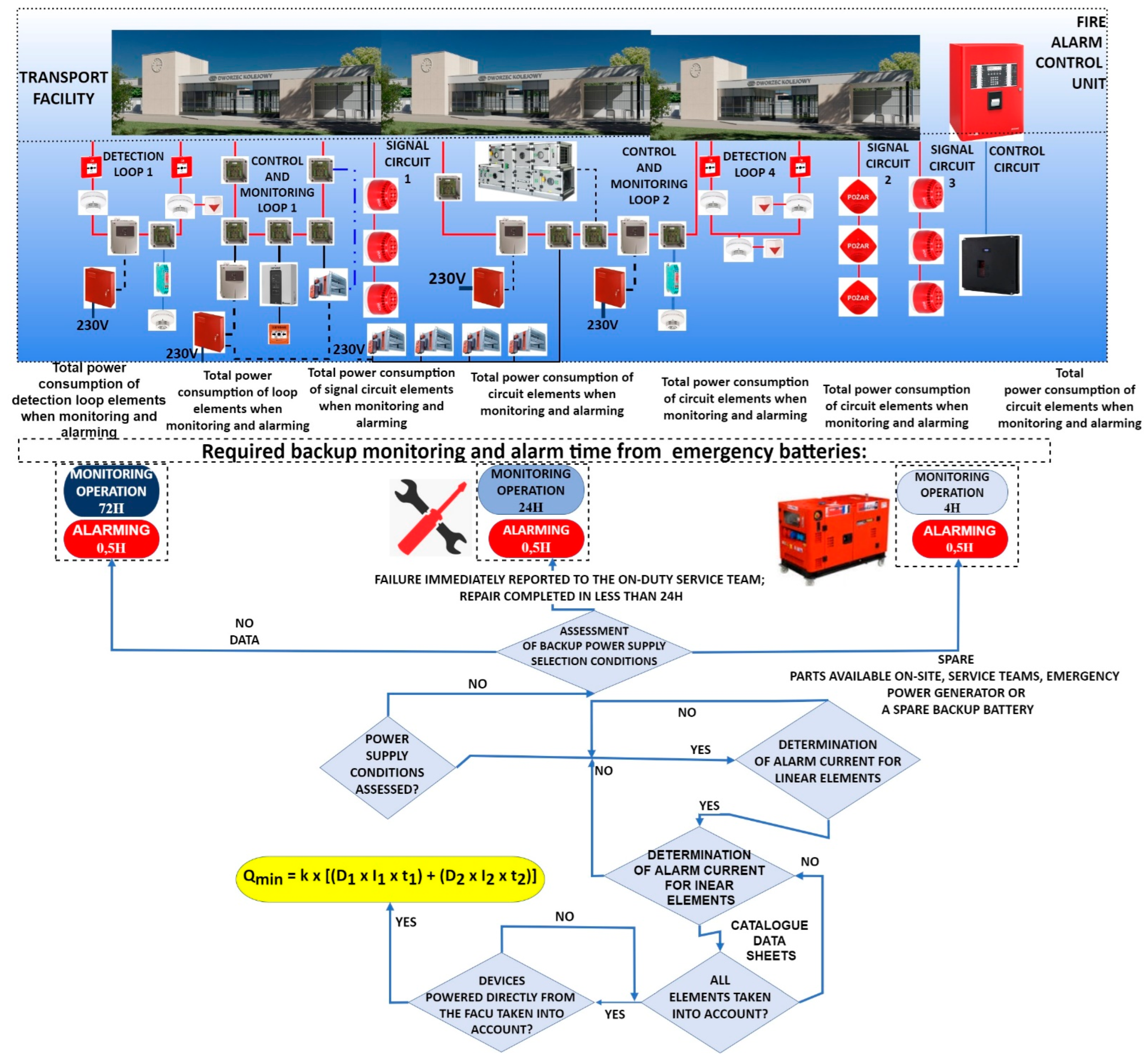
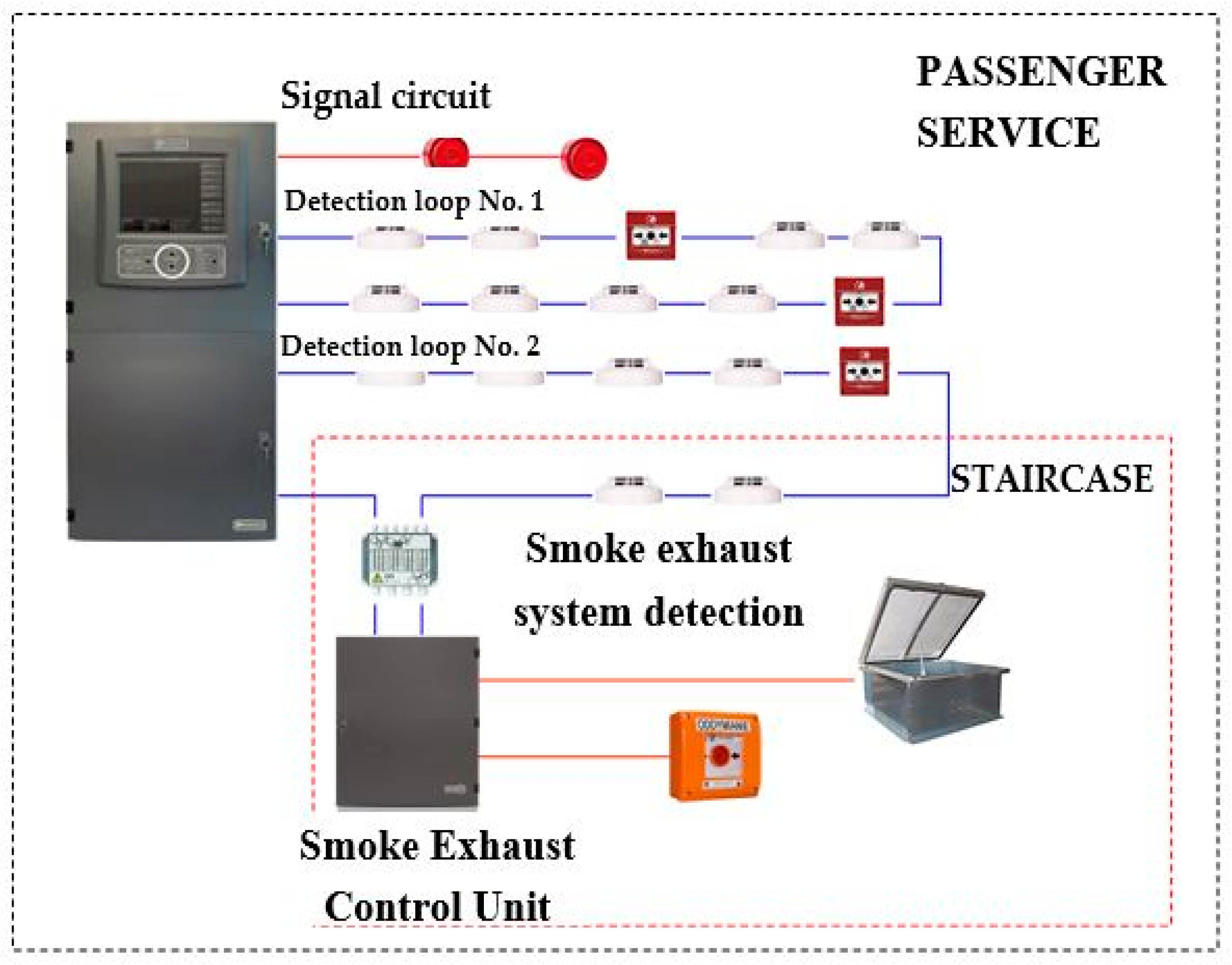


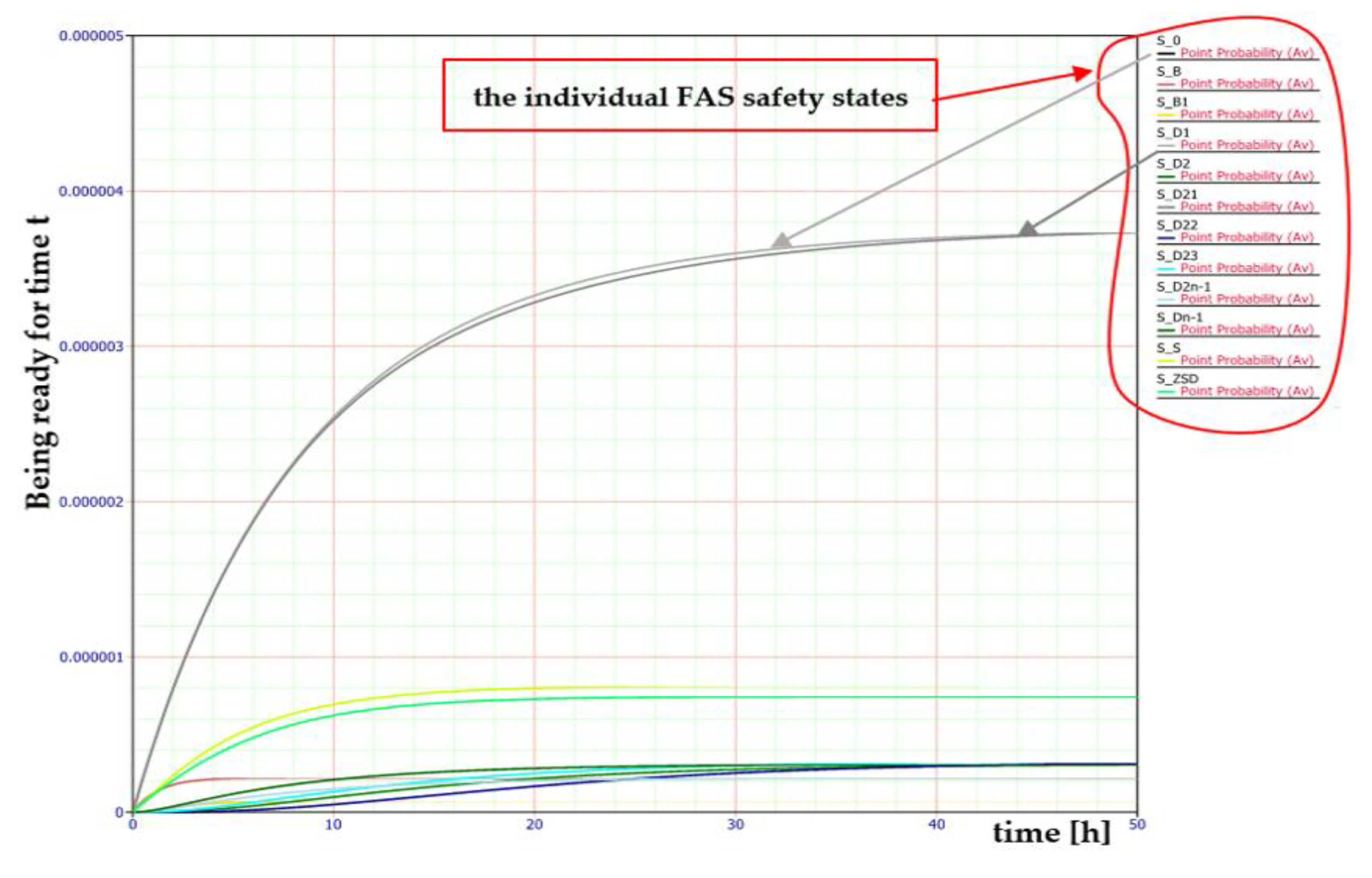

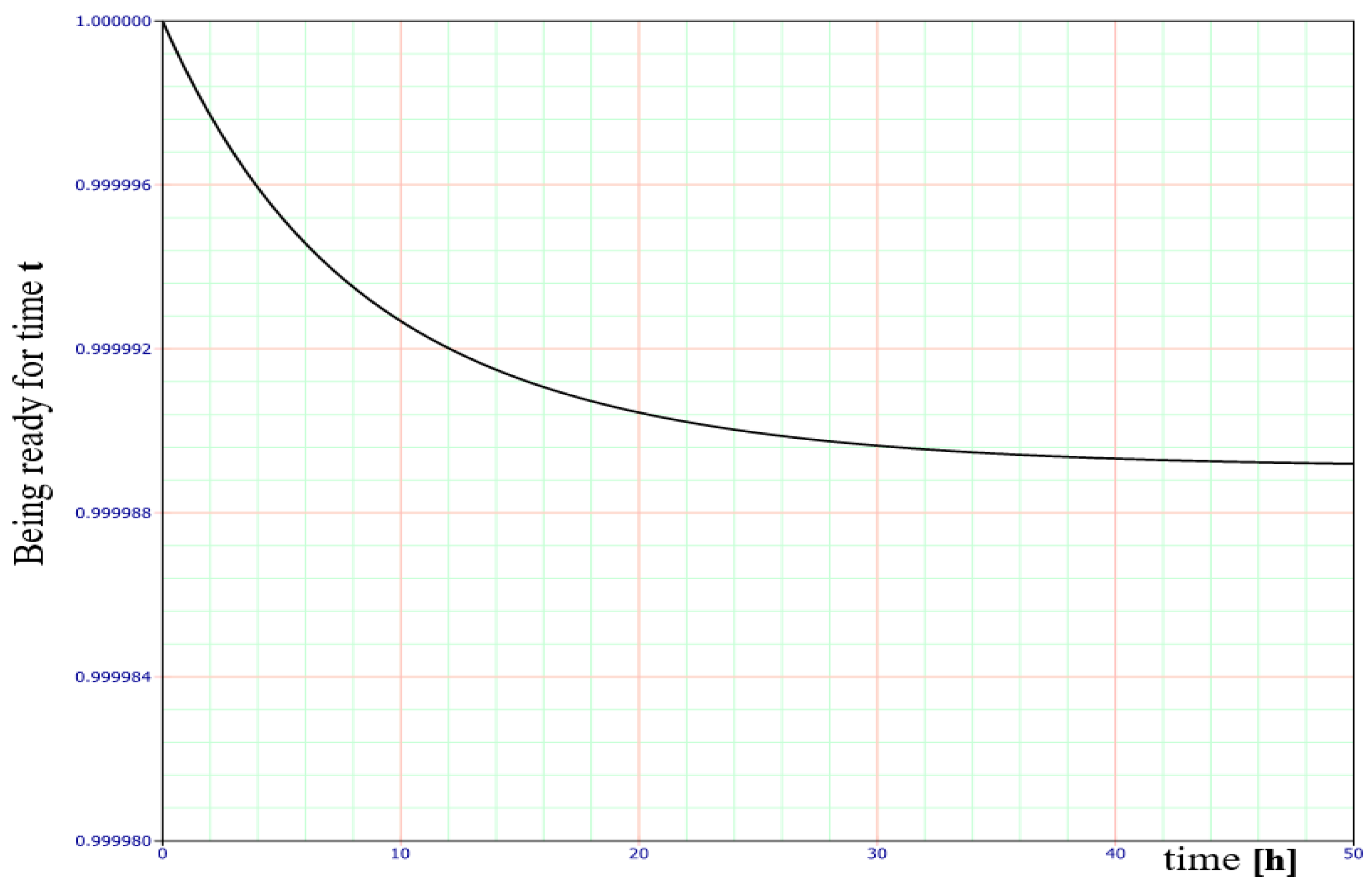

| Computation Step | Time [h] | Availability (t) | Reliability (t) |
|---|---|---|---|
| 0 | 0 | 0 | 0 |
| 1 | 1.125 | 0.9999986 | 0.999999 |
| 2 | 2.125 | 0.9999976 | 0.999997 |
| … | … | … | … |
| 8758 | 8758.125 | 0.999989 | 0.98858 |
| 8759 | 8759.125 | 0.999989 | 0.98858 |
| 8760 | 8760 | 0.999989 | 0.98858 |
Publisher’s Note: MDPI stays neutral with regard to jurisdictional claims in published maps and institutional affiliations. |
© 2022 by the authors. Licensee MDPI, Basel, Switzerland. This article is an open access article distributed under the terms and conditions of the Creative Commons Attribution (CC BY) license (https://creativecommons.org/licenses/by/4.0/).
Share and Cite
Klimczak, T.; Paś, J.; Duer, S.; Rosiński, A.; Wetoszka, P.; Białek, K.; Mazur, M. Selected Issues Associated with the Operational and Power Supply Reliability of Fire Alarm Systems. Energies 2022, 15, 8409. https://doi.org/10.3390/en15228409
Klimczak T, Paś J, Duer S, Rosiński A, Wetoszka P, Białek K, Mazur M. Selected Issues Associated with the Operational and Power Supply Reliability of Fire Alarm Systems. Energies. 2022; 15(22):8409. https://doi.org/10.3390/en15228409
Chicago/Turabian StyleKlimczak, Tomasz, Jacek Paś, Stanisław Duer, Adam Rosiński, Patryk Wetoszka, Kamil Białek, and Michał Mazur. 2022. "Selected Issues Associated with the Operational and Power Supply Reliability of Fire Alarm Systems" Energies 15, no. 22: 8409. https://doi.org/10.3390/en15228409








